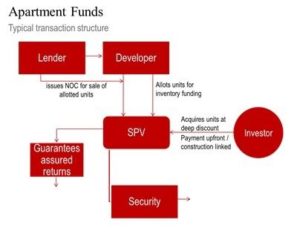
Akshit Shah, Associate Director – Capital Markets Research, JLL India
By Akshit Shah, Associate Director – Capital Markets Research, JLL India
What is Apartment Funding?
Apartment Funding (AF) is a fund-raising structure where the involved investors acquire real estate units at deeply discounted prices. It appears a similar structure to bulk buying; however, unlike in bulk buying, the developer needs to make coupon-linked payments to the investors, which can be customized to suit developer’s preferences. While the developer might get a payable-when-able option, he also agrees to buy back the units at pre-determined returns if the desired sales rate is not achieved within a pre-defined period.
 Why would either party enter into such a trade?
Why would either party enter into such a trade?
Such deals are win-win propositions for both the stakeholders. Developers preferred such structures for two reasons:
1) Quick sale of multiple units supported their financial needs, and
2) Funds raised by this route had no restrictions on usage.
For their part, investors:
1) Got preferred units at deep discounts, along with interest and an option to exit at a predetermined rate
2) Could potentially also get a pledge of shares depending on deal structure and corporate guarantee of SPV hosting the property in question, and a personal guarantee of the developer.
The risk factor in an apartment funding arrangement is relatively similar to the risk encountered in a typical construction finance funding arrangement, without a direct control on the project. The lack of control on the project is compensated for by much higher returns, so an apartment funding structure is ideally suited for investors who prefer developers with good track records.
Why is it the end of apartment funding structures?
In 2016, the Government of India cleared the Real Estate Regulation and Development Act (RERA). The name itself suggests the purpose of the Act – to regulate the real estate sector, where transparency was a big challenge in the past. One of the major regulation in this act requires developers to deposit 70% of the receipts through any kind of sale in an escrow account, which is to be used for project expenses. This money is not available to the promoter developer until completion of the project.
With this regulation, the key benefit for the developers to get upfront funding from apartment funds is lost. While the developers receive all the money, they can take out only a small part of it for purposes other than project-related expenditures.
Also, with GST being introduced, the cost of purchase has increased by 6.5–7% for under-construction projects. Earlier, developers were charging VAT + Service Tax, which together accounted for approximately 5–5.5%. We are now looking at a tax of 12% post GST.
Newer ‘greenfield’ projects will get the benefit of full input credits, which can be passed on to the buyer and offset the additional tax cost. For under construction projects, since most of the projects were partially built in the earlier tax regime, only a portion of input credit can be availed.
This will increase the cost of purchase, making it rather unattractive for investors who would earlier have considered apartment funding as an investment route. Since the basic purpose of the structure now effectively stands defeated, apartment funding and most similar structures are no longer feasible or even possible.
